|
|
 21 Aug 2005 @ 01:11, by jmarc. Technology 21 Aug 2005 @ 01:11, by jmarc. Technology
Well, this is pretty cool.
Wireless headphones
for the computer. More >
|
|
|
|
 19 Aug 2005 @ 20:20, by ming. Technology 19 Aug 2005 @ 20:20, by ming. Technology
Yesterday I was at the launch event for 23 in Copenhagen. I'm on vacation in Denmark at the moment. "23", spearheaded by Thomas Madsen-Mygdal, is a photo storage and sharing website. Well, there are several of those already, but these guys seem to have gone a good deal further and really created a system that does what most people actually need and want. It seems quite suited to replace whatever local program you store your digital photos in. I use iPhoto. 23 does most of what iPhoto does, and most of what Flickr does, and some things none of them do. While still appearing very simple. You can add photos a number of ways. By e-mail, by an upload, either individually or as a zip file, from a URL, or from plugins to iPhoto or similar programs. You can organize your photos in a number of ways, like tagging them and putting them in albums. You have finegrained control over who can look at the photos. They can be all private, they can be public, or you can give particular people access to particular photos or albums. You can subscribe to photos from certain people or with certain tags. Even with a free account you can upload lots of photos, and with a very cheap paid account you have unlimited storage. Doesn't scare them at all that lots of folks are going to upload the multiple gigabytes they have on their disks already. The system is very new so you might well run into quirks, or things that aren't there yet. And there are less than 100 users right now. But overall it seems very well designed. They've thought a lot about the usability, and interviewed many people about how they use photos and what they need. Anyway, be one of the first to check it out. More >
|
|
|
|
 2 Aug 2005 @ 18:42, by scotty. Technology 2 Aug 2005 @ 18:42, by scotty. Technology
My good friend Wayne Parker ( [link] ) has had a really
wonderful brilliant idea !!
And I woudln't be the adorable wee Scot that you all know and love if I passed up the chance to pass this on to you !!
First let me give you a wee bit of background on Wayne.
Wayne is an amazing graphic artist turned website designer
and while he earns a portion of his living creating websites
for people - what he wants most is to empower people to make
their own websites.... isn't that great !
To quote Wayne - "A website is a highly personal piece of
real-estate on the internet and having someone else create
it, is like having someone else write your diary."
So - what Wayne did was create a course that he could teach on the telephone - to teach people who don't know anything about website design how to create a web page!
Cool eh?
Here is what one lady said after taking his course...
"Wayne, you definitely deserve a two thumbs up."
"I started your web design class as a true beginner. I had
no technical knowledge and I was even a little scared of the
subject. I thank you so much for making the lessons simple
to follow and for all your guidance and patience through the
process."
"I am thrilled that after just 10 classes I have my own
website up and running! Thanks again for making it fun and
easy. You opened up a whole new world for me. I can't wait
to create more sites."
"I highly recommend your class to everyone, and I look
forward to taking your Web Design Advanced class."
Namaste
Jennifer Hardy ( [link] )
Burnaby, BC Canada
So - if you're interested in learning how to create your own
web site but always thought it was much to hard to do - this
course is for you!!!
(And it is only 97$ for this time around.)
This course is done on a conference line in the USA.
Long distance charges do apply but it is easy to get long
distance for US and Canadian residence for 5 cents a minute.
If you live in a different country besides Canada and the
US and you gather 6 or more people who speak English Wayne
would be more than happy to make arrangements to teach your
class !!
So reserve your seat at [link]
Now ! - 'cos the class is filling up fast!!
Oh - and just in case you're wondering why I've decided to post this about Wayne - well - I love what he does enough to share it with the world ! Well - you fellow NCN'rs anyway!
So please don't forget to tell Wayne I sent you !!
You can contact Wayne either through the website - or perhaps you'd prefer his e-mail address - which is .. wayne@themagichappens.com
|
|
|
|
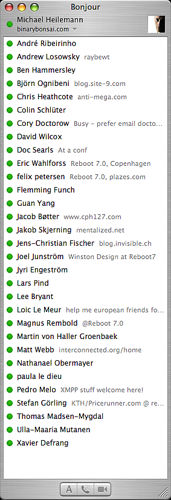 13 Jun 2005 @ 22:58, by ming. Technology 13 Jun 2005 @ 22:58, by ming. Technology
This is a snapshot that Michael Heileman took from his iChat program during the Reboot conference.
If you didn't know, Apple has this protocol called Bonjour, which used to be called Rendezvous. That was a better name, but somebody else sued them for the rights to it. Anyway, what it does is, quite automatically, to notice who's close by on the same local network. So, this is not this person's buddy list across the net. Here it is the people who're present in the same room. Which he might or might not know.
You open up your laptop computer and, bing, right away you see this. And you could of course send these people messages and chat with them, if you had the need. The point is that it is super-easy and automatic. You don't have to go and ask anybody for their username or anything.
This has so far been a Mac-only trick. But Bonjour has just become open source and will become available for any other platform too. There's no particular reason for it to be Mac only. David Weinberger was sitting typing away on his IBM Thinkpad, so he didn't show. It was about 1/2 each of Mac and Windows in that particular location. Windows has never been cool, and amongst famous techie bloggers, a Mac Powerbook is by far the platform of choice. Anyway, that's not the point. Would be better if this worked, no matter what you were running.
Bonjour/Rendezvous is also what enabled instant collaboration through a program called SubEthaEdit. It works over Bonjour. So, you open it up, and instantly you can see who's working on documents in your local area. And if they let you, you can join in in editing the documents. Which looks absolutely magical for collaborative note taking. Each person gets a different color, and all changes are being shown in real time. And it actually works. You can add to other people's notes, take turns, make corrections, etc. Some people are good at taking quotes down verbatim, others are really good at organizing the whole document. And it is basically done when the speech is done, and can be uploaded to a website, for even more people to look at.
I stayed at a Hotel in Vienna for BlogTalk last year. Nobody had said anything about the connection in the hotel, but there was a plug, and as a good techie I scanned the ethernet traffic and guessed at what settings to use and got online in no time. And lo-and-behold, a few other people showed up on rendezvous who had done the same, and I could instantly ask them when the program started, which I somehow had missed too. Plus help somebody who hadn't guessed what IP number to use for the router.
Anyway, nothing new for the folks who're using this all the time, but a little technical magic to share with the people who don't. More >
|
|
|
|
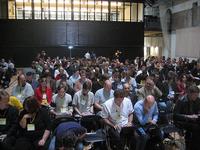 12 Jun 2005 @ 19:47, by ming. Technology 12 Jun 2005 @ 19:47, by ming. Technology
The Reboot conference in Denmark was very enjoyable. Nice to be in my home country for a couple of days, and lots of great speakers and contacts.
I'm by now used to that a techie conference like that is very wired, but it is still something that would probably be weird to many people. When somebody's speaking, about half the audience is sitting typing on their laptops. They check any websites mentioned, they make collaborative notes, they chat on IRC, they post to their blogs, they coordinate where to go for dinner, or they do whatever they feel like. The result is that there are more dimensions to whatever is going on, and that you probably are more informed, and information is more cross-indexed for you.
Through the magic of tags, you can see most of the blog postings from participants on the Technorati reboot page. It doesn't work great for me personally to make blog postings in real-time, but it is cool that it works for lots of other people. Before a speech even is over, you'll see the first blog postings, and you'll see the pictures people have posted to Flickr. Right this second, there are 1035 photos posted to Flickr on Reboot, and 91 blog postings found by Technorati.
I can't mention everything, but a few highlights from the program...
Inspired keynotes by Doc Searls and David Weinberger, two of the authors of Cluetrain Manifesto. Weinberger was on fire, as somebody said. Doc is always entertaining.
Keynote by Cory Doctorow. In addition to being a science fiction author and editor of BoingBoing, Cory is a big champion for EFF. He talked about some of the latest battles, like the Broadcast Flag. He is very skilled at boiling the issues down to the essential hardhitting facts. There are companies and government agencies in the pocket of Hollywood media companies that work very hard on delivering LESS to you, for MORE money. "Sorry, we've revoked your right to record that TV program".
Lee Bryant on
Negotiating Language and Meaning with Social Tagging. Lee is brilliant and provides great examples of how to use some of this cool technology in real and practical settings. Like for effective community websites for non-profit and government institutions. His recipees are very worth examining.
 Ben Hammersley is crazy and entertaining. His talk, 300 Years of Blogging, Etiquette and the Singularity, presented the idea that blogging has parallels to the phenomenon of papers with comments on issues of the day that were handed out and discussed in coffee houses in England 300 years ago. And he made some intriguing comments on how rudeness and embarrassment might be bigger issues than technology on the net for most people. You know, for his grandmother, the issue of adware on her computer putting stuff up she doesn't want is just so damned rude. It isn't an issue of what flaws IE might have, it is just rude behavior. And how some people might be very conscious of what other people might think, and therefore hold themselves back from doing stuff they technically could do easily. Like his wife who wanted to participate in a certain game, but was afraid to, because she didn't want to be seen doing something wrong, or accidentally messing something up for somebody. Ben Hammersley is crazy and entertaining. His talk, 300 Years of Blogging, Etiquette and the Singularity, presented the idea that blogging has parallels to the phenomenon of papers with comments on issues of the day that were handed out and discussed in coffee houses in England 300 years ago. And he made some intriguing comments on how rudeness and embarrassment might be bigger issues than technology on the net for most people. You know, for his grandmother, the issue of adware on her computer putting stuff up she doesn't want is just so damned rude. It isn't an issue of what flaws IE might have, it is just rude behavior. And how some people might be very conscious of what other people might think, and therefore hold themselves back from doing stuff they technically could do easily. Like his wife who wanted to participate in a certain game, but was afraid to, because she didn't want to be seen doing something wrong, or accidentally messing something up for somebody.
 Jimbo Wales, the founder of Wikipedia, talked about ... Wikipedia. An interesting angle is that he doesn't at all consider it this emergent swarm phenomenon. It isn't just a chaotic buzz of little ants that do different things, and that somehow a useful encyclopedia emerges from that. On the contrary, it is quite hierarchical. Yes, anybody can in princple go and, anonymously, write and change anything they like. But, really, that's mainly for PR. Most things get written or edited by a rather small percentage of known users. It is a community. A community where people have taken on particular roles, based on their track record, reputation, and how well trusted they are. Most things get worked out by real people talking them over, not by any automated voting system or anything. Some people have more say than others, because they've earned it. Jimbo Wales, the founder of Wikipedia, talked about ... Wikipedia. An interesting angle is that he doesn't at all consider it this emergent swarm phenomenon. It isn't just a chaotic buzz of little ants that do different things, and that somehow a useful encyclopedia emerges from that. On the contrary, it is quite hierarchical. Yes, anybody can in princple go and, anonymously, write and change anything they like. But, really, that's mainly for PR. Most things get written or edited by a rather small percentage of known users. It is a community. A community where people have taken on particular roles, based on their track record, reputation, and how well trusted they are. Most things get worked out by real people talking them over, not by any automated voting system or anything. Some people have more say than others, because they've earned it.
 Saturday night was a showing of the famous 1968 Doug Engelbart demo. "The mother of all demos". A bunch of smart people at the Stanford Research Institute in Menlo Park showed how they imagined computers should work in the future. At a time when computers mainly were big mainframes that did nothing of the sort. They invented the mouse, and one could click and drag (sort of) on the screen, and draw lines directly on the screen. And one could collaborate on a document, with video conferencing, and create outlines of information, etc. It was both amazing for the amount of foresight those guys had, and for a look into how terribly difficult it was. They could just sort of barely hold the system together for the demo, with six people and a whole lot of the most expensive hardware they could get their hands on. Doing things we nowadays take for granted, but which only got to happen because pioneers like them MADE it happen, against the odds. Doug Engelbart himself introduced the video over an iChat video link, and participated in a Q&A afterwards. Which I didn't stay for, because it was getting really late. Saturday night was a showing of the famous 1968 Doug Engelbart demo. "The mother of all demos". A bunch of smart people at the Stanford Research Institute in Menlo Park showed how they imagined computers should work in the future. At a time when computers mainly were big mainframes that did nothing of the sort. They invented the mouse, and one could click and drag (sort of) on the screen, and draw lines directly on the screen. And one could collaborate on a document, with video conferencing, and create outlines of information, etc. It was both amazing for the amount of foresight those guys had, and for a look into how terribly difficult it was. They could just sort of barely hold the system together for the demo, with six people and a whole lot of the most expensive hardware they could get their hands on. Doing things we nowadays take for granted, but which only got to happen because pioneers like them MADE it happen, against the odds. Doug Engelbart himself introduced the video over an iChat video link, and participated in a Q&A afterwards. Which I didn't stay for, because it was getting really late.
Lots more, but you can find plenty of commentary in the other sources. More >
|
|
|
|
10 Jun 2005 @ 20:21, by vaxen. Technology
License To Chill -- Hackers Hamstring Rights Violators
SUMMARY: International hacker organization issues software license that allows the group or its licensees to take human rights violators to court.
CROSSHAIRS: This story is important for anyone interested in hacking, human rights, information security, open-source software, Internet censorship, international law, international politics, or technology transfer. More >
|
|
|
|
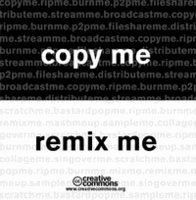 25 Mar 2005 @ 17:00, by ming. Technology 25 Mar 2005 @ 17:00, by ming. Technology
Yahoo has a new search feature, for materials with Creative Commons licenses. I.e. typically stuff you can use freely if you just mention where they come from, or maybe that you can only use non-commercially.
Wait, how do they know? I search for my own blog, and it came up with a page here where indeed I mentioned that I consider what I write here to be in the public domain. Really, what I should do should be to put a proper CC image and link here that says so. I've so far labeled it as Primarily Public Domain which really fits best. But I like the idea that a formalized piece of xml will be allow various services to automatically find content with a certain license or dedication. So, I've added the public domain code from CC in my sidebar now.
Anyway, there's a growing number of ways one can search for liberally licensed content.
America Free TV gives you online streaming video programming like that.
OurMedia offers free hosting for CC licensed media.
Of course Creative Commons itself has a search.
Flickr lets you search for pictures based on their licenses. Flickr who btw was bought by Yahoo this week, who promises to let them keep doing what they're doing.
I'm sure there are others. More >
|
|
|
|
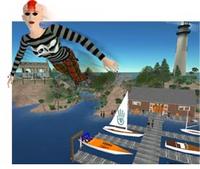 11 Mar 2005 @ 12:19, by ming. Technology 11 Mar 2005 @ 12:19, by ming. Technology
Second Life is a massively multiplayer online world. One can build stuff, design one's own avatars (virtual bodies), one can program it. One is the owner of what one creates and there's opportuties for trade and business. Via BoingBoing, here are some notes from a speech by Cory Ondrejka, the VP of Product Development for Linden Labs, the company that makes it.Second Life allows users to collaborate and teach each other. Learning scripting: it’s easy, you have immediate feedback, and other people are willing to help. People spread knowledge and do FAQs. SL really encourages this. As an example: skydiving classes, ingame. Players sell lessons and parachutes. Skydiving became a huge fad in SL for a while. Abbot’s Skydiving sells equipment and airplanes to go up in. An elevator to 4000 feet. Total freedom to create. A service.
Another example of collaborative business: VERTU is a group in RL. They contacted the EFF and wanted to do a fundraise in SL. They raised 1700 bucks. Next month (for Charity X) they did 1900. Then for Hurricane Relief = 2000 US. People in these spaces recognise the virtual currency has value. Philanthropy, giving .. having an impact back on the RL is a real possibility.
Tringo, the current SL fad. A cross between tetris and bingo. Someone in SL wanted a fun social game to play ingame. He created Tringo. In the 3 months since, he’s generated the equivalent of 4000 US in Tringo. He just licensed the realworld distribution rights to Tringo to a mobile game company. Because SL lets him maintain the rights to his IP, he can distribute said rights in the real world, although apparently part of the deal is that he continues to manage the rights individually ingame. Gee, I don't have time, but I could really get into that. I was hooked on Alphaworld, oh, almost 10 years ago. My buildings were still there, last I looked. But the environment didn't advance a whole lot since then, and there wasn't all that many people there. And there are so many more cool things one can do with virtual worlds. I've of course noticed that games have gotten much more fancy graphically in the meantime. But I don't have any particular interest in the types of games where you walk around and get killed all the time, by folks who've got bigger guns than you have. But I like building stuff. Second Life looks quite similar to Alphaworld, so it is not that things have advanced enormously. But the increased programability makes the difference. Sounds like Second Life is getting a lot of things right. So, if I just had some quiet weekends with nothing to do.
|
|
|
|
 10 Feb 2005 @ 16:00, by ming. Technology 10 Feb 2005 @ 16:00, by ming. Technology
Google has a new Map service. Which maybe at first looks like any other online map thing. You can see the streets in some area, map a route somewhere, search for addresses and that kind of thing. But Google has a knack for making services that are really simple, and look really simple, but that use a lot of hidden wizardry. They effortlessly do things that most professional web developers would swear would be impossible to do in a webpage. But, ok, we're catching on now. So whenever they come out with something new, somebody will dissect it and tell us how they did it.
There's Google Suggest that magically can provide you lists of possible search terms as you're typing, complete with number of matches for each. Chris Justus did a thorough job dissecting that. They use the XMLHttp for exchanging data with the server in real time.
And there's Gmail. Again, seems very simple. But it does spell checking and addressbook lookups in real time. Stuff I had gotten used to accepting that one just couldn't do in webpages. But you can, with XMLHttp and with iFrames. And with some extremely responsive servers. Various people have analyzed Gmail, like John Vey. Part of their trick is that the user interface gets stored at the client's end, so that only data is passed back and forth to the server. As opposed to "normal" webpages where everything is sent from the server whenever you load a new page.
Now Joel Webber has dissected Google Maps. So, some of the same tricks again with real-time server communication, in part using a hidden iframe. And then there's the infinitely scrolling maps. The trick is in part to make them out of little tiles, and removing some at one end while adding new ones at the other end, in real time. And routes are added on top with transparent PNG files.
Now, if somebody could just pay me for duplicating some of those tricks so I can get time to study up on them. Or my skills are suddenly getting a little old. More >
|
|
|
|
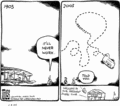 10 Jan 2005 @ 10:37, by jazzolog. Technology 10 Jan 2005 @ 10:37, by jazzolog. Technology
Tom Toles' great work is available all the time online at [link] .
~~~~~~~~~~~~~~~~~~~~~~~~~~~~~~~~~~~~~~~
The great man is one who never loses his child's heart.
---Mencius
In eternity there is indeed something true and sublime. But all these times and places and occasions are now and here. God himself culminates in the present moment, and will never be more divine in the lapse of all the ages.
---Henry David Thoreau
The art of being wise is the art of knowing what to overlook.
---William James
James' implication of course is what not to overlook either. Am I seeing things or is Tom Toles becoming even more brilliant with each day? This cartoon is for yesterday but should live through the ages. It has layers of meaning that make me want to ask a lot of questions. More >
|
|
<< Newer entries Page: 1 2 3 4 Older entries >> |
|